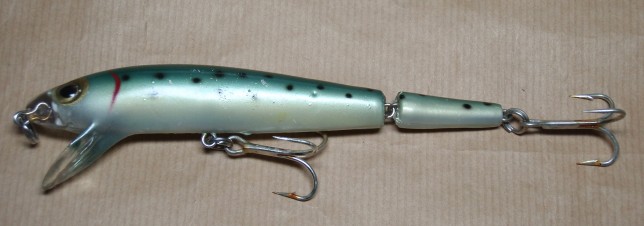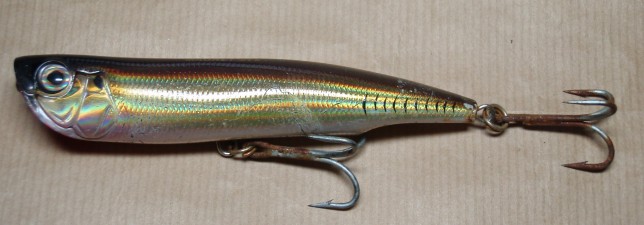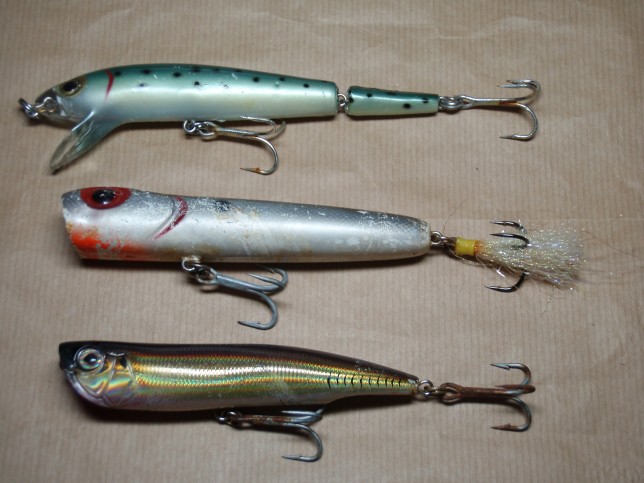By Ian Morris
The purchase of some new lures whilst on holiday in France, and then a couple of trips to Ireland, give Ian Morris the opportunity to reassess the place that surface poppers have within his bass angling repertoire.
Despite catching many bass on plugs, I have never, until recently, had much luck with surface poppers.
I have impulse bought quite a few such plugs after reading various BASS magazine articles and gleaning other information from members. I genuinely thought that I had given the poppers a fair old go, whenever conditions permitted, but with the benefit of hindsight, I have now changed my mind. You know how it is, you never have faith in a new method or lure until you have had a few successful sessions using it.
I think that my lack of success using surface poppers has manifested itself in the form of two main problems. Firstly, I always prefer to fish a minnow lure first rather than a popper, so most of my popping was probably done as a last resort following dozens of fruitless casts with the minnow. This probably meant there were actually no bass, or very few, around to be caught anyway. Secondly, if there were fish around, then I would catch pretty quickly using the minnow, and therefore I would be reluctant to switch to the popper because the minnow was already ‘doing the business’.
In reality, the poppers never really got a fair ‘crack of the whip’ and understandably remained very much my second choice. Nonetheless, I have been able to catch a few bass on the Chug Bugs and Skitterpops, but only on those occasions when I had blanked with the minnows, or got bored and switched to poppers.

A slight change in fortune in my attempts with surface lures came about during a promising evening session last year, whilst on a visit to Ireland. I quickly caught three or four bass, and as there were obviously a few bass about, I actually switched to the popper to target these fish that I already knew to be present. The result was some spectacular action. There were a few takes missed but a nice 41b l2oz bass was hooked, and landed, from range.
Until this year, most of my popper caught bass have actually hit the lure as soon as it landed on the water, so I wasn’t actually experiencing the excitement of seeing the swirls as fish made repeated strikes at the twitching plug, so well described in the magazine by our more accomplished ‘chuggers’.
Last season I fished my Welsh marks really hard, and during the course of many sessions, caught dozens of bass on minnows, but I had just half a dozen on poppers. Then this Autumn, I have been lucky enough to make two trips to Ireland in quick session. The first was to Co. Kerry, and the second to Co. Cork. I have been treated to some magical fishing that has resulted in a change of approach to surface popping, and to my plugging in general.
A howling easterly gale on the last afternoon of our Kerry trip saw Geoff, Mark and me head for the comparative shelter of a harbour and strand that we knew. Fellow B.A.S.S. members had enjoyed good fishing the day before, but the place looked lifeless. We tried instead the football pitch at the extreme eastern end of another Strand, where there was a nice swell rolling in, though the sea surface was blown quite flat by the strong crosswind.
I headed out across the rocky fingers armed with the trusty black and chrome Thunderstick. A couple of casts quickly showed me that the ground was too extreme even for this, the shallowest of divers, unless fished very, very slowly over the top of the gullies and ridges of rock that were only just covered by the advancing tide. This was clearly a good opportunity to try a popper.

Whilst camping last summer, on the French Atlantic Coast, I had spent some hours in a very well stocked tackle shop ‘umm-ing and ahh-ing’ about whether I really did need to treat myself to yet more plugs. I eventually decided on a surface popper that really did ‘look the business’. It was made by Duel, and was the called an Aile Magnet. It was most realistic looking lure I’ve ever seen. I bought a brace of the 18 gram, 105 mm versions, one in sandeel pattern, and the other in joey mackerel. Fitted with strong razor-sharp saltwater hooks, these lures have a couple of magnetic steel balls inside, which fly to the back of the plug under the force of the cast, so as to give it a weight-forward character, this, combined with the tapered rear-end means that very long dart-like casts can be made, even into a headwind. As soon as the plug hits the water the ball bearings release and act as a rattle.
Anyway, back to the footy pitch . . . .
With the wind hard on my back, my first cast with the sandeel pattern popper brought a couple of swirls then a take from a fish. It was only on for a few seconds before it threw the hooks and got off. . .. ‘Basstar. . . !’. Three casts later another fish hit, but again it was lost as it turned on its side to power over a semi-submerged ridge through thrashing fronds of wrack… ‘Basstar…!’. Two good fish lost in such quick succession was almost too much to bear!

My shouts of ‘Bass…. get a popper on. There are bass everywhere!’, had my two pals ditching their float gear and maniacally rooting through bags and pockets looking for poppers. Before either of them had made a cast, I was solidly into a third fish that hit the plug a mere rod length away from me. And surged out of the gully, launching itself clear of the water in the most violent of takes. It was truly one of those heart stopping ‘Ya-hoo!’ moments in fishing. The fish gave me a rare old run-around before eventually being safely netted. It weighed over 5lbs 8oz. I was well chuffed, as they say, and encouraged the other two to get some of the action whilst I weighed and measured my fish before returning it.
Geoff opted for a chrome-blue Saltwater Chug Bug. Mark had left his poppers in another bag, so improvised by somehow hooking the two trebles of a Jointed Thunderstick together so that he could twitch it back across the surface to simulate a badly injured fish. He got plenty of swirls, but no takes. Possibly, the hooks were being masked in such a way as to prevent any positive hook-ups. Geoff was persevering with the Bug but getting no swirls. I was into my second fish soon after returning the first. This one weighed 31b 8oz.
I called to Mark and threw my spare Duel popper over to him, ‘Give that a go you scrounging Mancunian so-and-so’, I said. ‘There must be lots of fish here’. To cut a long story short, Mark and I had, between us, fifteen bass in a couple of hours, by using the Duel poppers. Geoff fished between us, either side of us, and in front of us, but for some reason, try as he might, the bass ignored the Chug Bug. It seemed very odd, because, even though there was a howling wind, it was bright and sunny, and the water was gin-clear. I wondered if, on this occasion, it was the realism of the Duel lures that had made a difference.
Eventually Geoff gave up. He turned his attention to the mullet that were, by then, gorging themselves on the seaweed fly maggots being washed out of a pile of rotting kelp, as the tide advanced over the rocks.
Mark and I eventually had to retreat upwards to sit on top of a grassy bank fifteen feet above the water. Dangling our legs over the edge like a pair of ageing Huckleberry Finns, we cast our plugs out to exactly the same spot and twitched them back in tandem, right next to each other, to see which one the bass were going to go for.
The fish we caught weren’t big. They averaged about 21b 8oz, but it was a cracking end to an equally cracking five days of fishing. We sat there ‘laughing our socks off !
I got the mackerel pattern Duel popper back from Mark just in time to take it with me on a short notice trip to Co. Cork.
It was early November, and I wanted to try the really rough plugging ground that Bob Moss has been ‘raving’ about for the past couple of years. I bought several Irish Ordnance Survey maps of the area. I also got confirmation from Bob’s pal and acknowledged local expert, John Hall, that I was, more or less, looking in the right area. I didn’t want to ask John direct questions as such, because, as I had never met him before, and the last thing I wanted to do was, turn up on his patch, take his knowledge, catch some of his bass and then disappear. Where, after all, is the challenge in that? Equally, Bob had been a bit vague in his description of the fishing in Cork. He also recognised that it was John’s ‘patch’ and not his.
In considering the bass fishing in Co. Cork, we are talking about an awful lot of coastline. This certainly is different than the comparative confinement of the Dingle Peninsula. Look at a map of Ireland, find the areas between Waterford to Skibbereen, and you will see what I mean. There is a lot of coastline.
It was good to hear from John, that by studying the maps, I had identified, more or less, the right places to explore. He said that if I found myself in the area near where he lives, he would, if he could find the time, meet me to squeeze a session in. This we did, though by the time we met up, I had already found myself some nice fish of 3lbs, 41b 8oz, and 7lbs 12oz. All these were taken on a jointed Thunderstick. I also landed a beauty of 81b 14oz on the joey mackerel pattern Duel popper. The morning session with John saw me back where I had earlier taken the 7lb 12oz fish. I got lucky again and bagged bass of albs, and alb 6oz, on the Thunderstick, as well as a personal best 9lb 8oz bass on the joey mackerel pattern Duel popper. It was caught in the late morning in bright sunny conditions and with cold northerly wind.
As well as the encouragement John gave me to enjoy this local fishing, he also gave me some advice; don’t stay put unless you really have no other choice. Cover as much ground as possible until you locate bass.
Many of you have marks that you know so well, to the point of knowing what state of tide bass are most likely to show up, but when you are fishing somewhere new, try to give each spot a maximum of six to ten casts then move on. Fish as far as you can along that stretch, taking mental note of likely looking spots and if fishing a flooding tide, hit those spots again on your way back.
Anyone having the pick of Ireland’s southern coast has the advantage of miles and miles of untouched and relatively un-fished stretches of coastline to wander along, but I expect most of us could find long stretches like that over here if we are prepared to put in a bit of effort. Look at maps and cover a few miles.
As far as lure fishing is concerned, I would now suggest that you vary things a bit by using poppers and minnows, and even bubble floats and redgills, at times. I believe that bass will take any lure, within reason, that you pass in front of it. It is, after all, a wild predatory creature that is hungry. Do remember to give those surface lures a go though. I am now convinced that the commotion you can stir up with a surface popper is more likely than a minnow to attract the attention of a bass, and unless the conditions are too rough, the first lure that I will clip on will be the Duel Magnet popper.

Author’s Footnote
The only place in the UK that I have been able to find Duel Magnet poppers, is Harris Angling. They only stock them in limited colours and in the 28g, l25mm version that, I feel, is a bit too large. Harris actually refer to these poppers as ‘sliders’. They have tried to explain to me why, but I still don’t really grasp it. For me, any plug with a dished front that floats on the surface, doesn’t dive and spurts out water from that dished front, is a popper. Anyway, I was put to task to get some like mine for Geoff and Mark, (as well as a couple of spares for myself) so Harris kindly ordered six in each colour from Japan. This is their minimum number for special orders. The codes are as follows: labelled as Aile Magnet SB, Size 105mm, Weight 18g, Floating. Bar codes for colours are “F659-HGM” for Mackerel, “F659-HAJ” for Sandeel. They are £8.95 each. This might sound expensive, but it is much less than I paid in France.
For an excellent lesson on how to fish surface poppers, read ‘Using The Chug Bug Big Bug’ by Steve Butler in BASS 86. Steve tells you all there is to know, and more. (enclosed with this pack)
If you decide to try fishing Ireland’s south coast, drop into Klontackle at Klonakilty and have a word with Will or Pete. They may put you on to some good marks, and the shop has a good selection of tackle.
This article originally appeared in B.A.S.S. Magazine No.102 – Summer 2002.